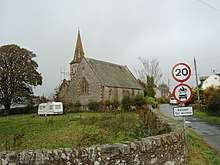Beeswing, Dumfries and Galloway
Beeswing is a small village in the historical county of Kirkcudbrightshire in Scotland. It was formerly known as Lochend in reference to its position near Loch Arthur, which lies to the east of the village and has been claimed as the setting for the Arthurian story of the Lady of the Lake.[1] The village was renamed to honour the famous racing mare, Beeswing.[2] The village formerly had a church, which has now been converted to a house.

Loch Arthur Community
The Loch Arthur Community at Beeswing, run by the Camphill Village Trust,[3] is a working farm with dairy, gardens and supported accommodation where people with learning disabilities live alongside volunteers in a way that 'recognises the dignity and uniqueness of each human being and does not distinguish between those who are called disabled and those who are not'.[4]
Over water village
There is a site on the western edge of the Loch (grid reference NX896694) that once held an "over water" village during the Stone or Bronze Age. The occupants of the village lived in pillar-supported buildings out in the loch, some 70 feet from the bank, allowing for safety and security. The Museum in Dumfries has a coracle which was found near this site in the 1930s.
References
- http://www.factfictionandconjecture.ca/files/legend_of_king_arthur.html
- "Archived copy". Archived from the original on 25 July 2007. Retrieved 17 October 2007.CS1 maint: archived copy as title (link)
- http://www.camphillvillage.org/
- "Archived copy". Archived from the original on 5 October 2011. Retrieved 4 June 2011.CS1 maint: archived copy as title (link)
Further reading
L. (1874) "Arthurian Localities: Scotland", Notes and Queries, s5-II, 36, pp. 181-182
External links
| Wikimedia Commons has media related to Beeswing, Dumfries and Galloway. |